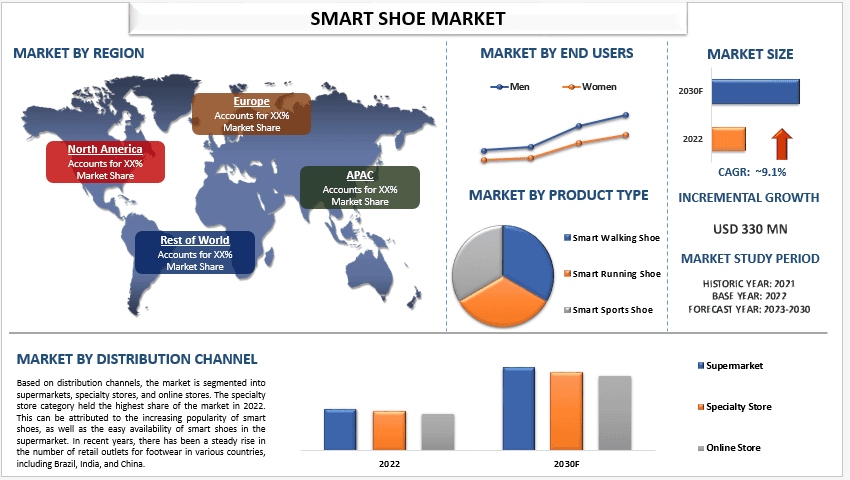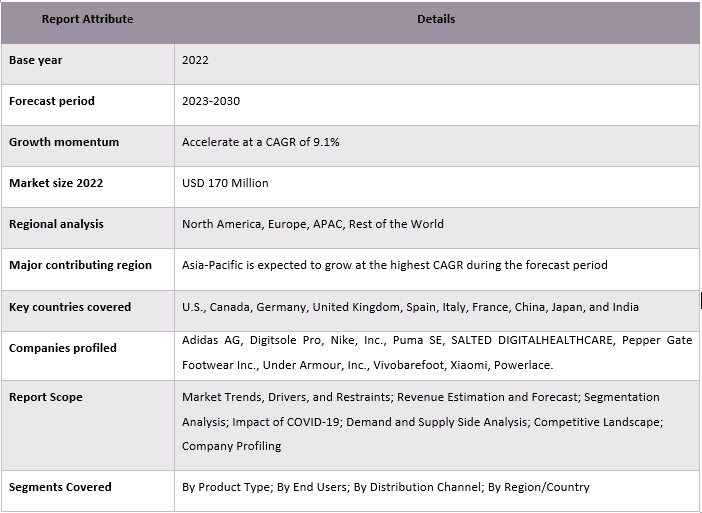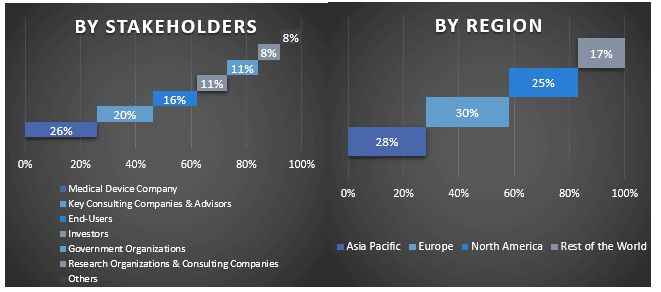スマートシューズ市場:現状分析と予測(2023年~2030年)
製品タイプ(スマートウォーキングシューズ、スマートランニングシューズ、スマートスポーツシューズ)の重視; エンドユーザー(男性、女性); 流通チャネル(スーパーマーケット、専門店、オンラインストア); 地域/国

スマートシューズ市場は、世界のフィットネス機器の利用増加を背景に、2022年に1億7,000万米ドルと評価され、2023年から2030年までの予測期間中に9.1%のCAGRで成長すると予測されています。例えば、RunRepeatが2021年10月に発表した調査によると、2020年には4億4,500万個以上のウェアラブルフィットネス機器が消費者に販売され、フィットネストラッカーの収益はCOVID-19の影響を受けた期間に31%以上増加しました。また、2022年に発表されたBusiness Deskのデータによると、英国の成人人口の25%以上が運動トラッカーを持っており、3分の1が毎日デバイスを装着しています。これに加えて、医療機器および履物会社による潜在的なスマートフットウェアを見つけるための製品発売の増加、スマートフィットネス機器開発のための研究開発活動の活発化、都市人口の増加もスマートシューズ市場を牽引しています。グローバルな履物製造大手は、ポートフォリオを拡大することで、統合技術を搭載した新しい靴を発売する可能性を示すためにあらゆる努力をしています。例えば、プーマSEのインド北部最大の店舗が2021年10月にインドのグルガオン市にオープンしました。約7,000平方フィートの広さを持つグルガオンのCyberHub小売ハブにある店舗は、「体験型店舗」であり、デジタルタッチポイントが戦略的に配置され、オンラインでますます多くの時間を費やしているデジタルに精通した顧客を引き付けています。
市場で活動している主要なプレーヤーには、Adidas AG、Digitsole Pro、Nike, Inc.、Puma SE、SALTED DIGITALHEALTHCARE、Pepper Gate Footwear Inc.、Under Armour, Inc.、Vivobarefoot、Xiaomi、Powerlaceなどがあります。
レポートで提示されている洞察
「製品タイプ別では、スマートスポーツシューズカテゴリーが予測期間中に高いCAGRで成長する」
製品タイプに基づいて、市場はスマートウォーキングシューズ、スマートランニングシューズ、スマートスポーツシューズに分類されます。スマートウォーキングシューズセグメントは、世界中でスポーツ活動が急増しており、スポーツウェア会社が革新的な製品を発売するきっかけとなっているため、予測期間中に大きなシェアを占めると予想されます。例えば、2021年には、バスケットボールスターのステフィン・カリーが、Under Armourが提供する自身のレーベルCurry Brandで、Curry Flow 9シューズという7部構成のフットウェアコレクションを発売しました。スマートウォーキングシューズは、スポーツ選手のバイタルを追跡する必要性が高まっているため、スポーツ分野で高い需要があります。トップオブフォームしたがって、スマートウォーキングシューズカテゴリーは、予測期間中に高いCAGRで成長すると予想されます。
「エンドユーザー別では、男性セグメントが2022年に大きなシェアを占めた」
エンドユーザーに基づいて、市場は男性と女性に二分されます。男性セグメントは、スポーツやジム活動における男性の主な存在により、2022年に大きなシェアを占めました。例えば、2020年には、国際オリンピック委員会(IOC)がアスリートとその取り巻きメンバー向けのビジネスアクセラレーター(BAC)コースを開始しました。オンラインBACコースには5,799人が参加し、そのうち59%が男性でした。また、技術の進歩、履物業界におけるアスレジャーのトレンドの高まり、病状に対する意識の高まり、都市人口の増加も、すべてこのセグメントの発展に貢献しています。したがって、男性セグメントは、2022年にアプリケーションの中で市場を支配しました。
「流通チャネル別では、オンラインストアセグメントが予測期間中に大幅な割合で成長する」
流通チャネルに基づいて、市場はスーパーマーケット、専門店、オンラインストアに分類されます。オンラインストアセグメントは、デジタルメディアの普及とソーシャルメディアマーケティングの普及により、高いCAGRで成長すると予想されており、これはさまざまな国のインターネット普及に大きな影響を与えており、売上の大部分はオンラインメディアを通じて行われています。また、消費者に強化されたケアを提供するためのいくつかの新製品の発売が、このセグメントの成長を牽引しています。例えば、Nikeは2021年7月に東南アジア諸国へのデジタルプレゼンスを拡大し、シンガポールやフィリピンからタイやマレーシア、台湾に至るまで、幅広い国をカバーするNikeアプリをこの地域に導入しました。これは、Nikeが堅牢なオンラインプレゼンスを確立しようとしているため、同社のこの地域におけるデジタルプレゼンスの大きな拡大を意味します。したがって、オンラインストアセグメントは、今後数年間で大幅な割合で成長すると予想されます。
「地域別では、北米地域が2022年に大きなシェアを占めた」
スマートシューズ業界の市場採用をよりよく理解するために、市場は北米(米国、カナダ、北米の残りの地域)、ヨーロッパ(ドイツ、英国、フランス、スペイン、イタリア、ヨーロッパの残りの地域)、アジア太平洋(中国、日本、インド、アジア太平洋の残りの地域)、世界の残りの地域などの国における世界的なプレゼンスに基づいて分析されています。北米は2022年にスマートシューズの市場を支配しました。最先端で革新的な製品の入手可能性、さまざまなスポーツへの意識の高まり、この地域の都市人口の増加がトラッキングデバイスの需要を高めており、スマートシューズ製品の発見への多額の投資がこの地域の市場を牽引しています。例えば、ValuePenguinの2022年の記事によると、米国市民の45%が定期的にフィットネストラッキングデバイスを使用しており、そのうち女性が55%、次いでGen Zが75%、ミレニアル世代が57%を占めています。北米は、2022年に地域の中でスマートシューズ市場を支配しました。
スマートシューズ市場レポートのカバレッジ

このレポートを購入する理由:
- この調査には、認証された主要な業界専門家によって検証された市場規模と予測分析が含まれています。
- レポートは、全体的な業界のパフォーマンスを一目で簡単に確認できます。
- レポートは、主要なビジネス財務、製品ポートフォリオ、拡張戦略、および最近の動向に重点を置いて、著名な業界の同業者の詳細な分析をカバーしています。
- 業界で普及している推進要因、制約、主要なトレンド、および機会の詳細な検討。
- この調査は、さまざまなセグメントにわたる市場を包括的にカバーしています。
- 業界の地域レベル分析の詳細な調査。
カスタマイズオプション:
グローバルスマートシューズ市場は、要件またはその他の市場セグメントに応じて、さらにカスタマイズできます。これに加えて、UMIは、お客様独自のビジネスニーズがあることを理解しているため、お客様の要件に完全に適合するレポートを入手するためにお気軽にお問い合わせください。
目次
スマートシューズ市場分析(2023年~2030年)の調査方法
世界のスマートシューズ市場の過去の市場を分析し、現在の市場を推定し、将来の市場を予測することは、世界の主要地域におけるスマートシューズの採用を構築し、分析するために実施された3つの主要なステップでした。徹底的な二次調査を実施し、過去の市場数値を収集し、現在の市場規模を推定しました。次に、これらの洞察を検証するために、多数の調査結果と仮定を考慮しました。さらに、世界のスマートシューズ市場のバリューチェーン全体にわたる業界の専門家との広範な主要インタビューも実施しました。主要なインタビューを通じて市場数値を仮定および検証した後、トップダウン/ボトムアップアプローチを採用して、完全な市場規模を予測しました。その後、市場の内訳とデータの三角測量方法を採用して、業界に属するセグメントおよびサブセグメントの市場規模を推定および分析しました。詳細な方法論を以下に説明します。
過去の市場規模の分析
ステップ1:二次ソースの詳細な調査:
スマートシューズ市場の過去の市場規模を取得するために、会社の内部ソース(年次報告書と財務諸表、業績プレゼンテーション、プレスリリースなど)や、ジャーナル、ニュースと記事、政府の出版物、競合他社の出版物、セクターレポート、サードパーティのデータベース、その他の信頼できる出版物などの外部ソースを通じて、詳細な二次調査を実施しました。
ステップ2:市場セグメンテーション:
スマートシューズ市場の過去の市場規模を取得した後、主要地域におけるさまざまなセグメントおよびサブセグメントの過去の市場の洞察とシェアを収集するために、詳細な二次分析を実施しました。主要なセグメントは、製品タイプ、エンドユーザー、流通チャネル、および地域としてレポートに含まれています。さらに、その地域でのテストモデルの全体的な採用を評価するために、国レベルの分析を実施しました。
ステップ3:要因分析:
さまざまなセグメントおよびサブセグメントの過去の市場規模を取得した後、スマートシューズ市場の現在の市場規模を推定するために、詳細な要因分析を実施しました。さらに、スマートシューズ市場の製品タイプ、エンドユーザー、流通チャネル、および地域などの従属変数と独立変数を使用して要因分析を実施しました。世界のスマートシューズ市場セクターにおける主要なパートナーシップ、合併と買収、事業拡大、および製品の発売を考慮して、需要と供給側のシナリオについて徹底的な分析を実施しました。
現在の市場規模の推定と予測
現在の市場規模の評価:上記の3つのステップからの実行可能な洞察に基づいて、現在の市場規模、世界のスマートシューズ市場の主要なプレーヤー、およびセグメントの市場シェアに到達しました。必要なパーセントシェアの分割と市場の内訳はすべて、上記の二次的なアプローチを使用して決定され、主要なインタビューを通じて検証されました。
推定と予測:市場の推定と予測では、ステークホルダーが利用できる推進要因と傾向、制約、および機会を含むさまざまな要因に重みが割り当てられました。これらの要因を分析した後、関連する予測手法(つまり、トップダウン/ボトムアップアプローチ)を適用して、世界の主要市場全体でさまざまなセグメントおよびサブセグメントの2030年の市場予測に到達しました。市場規模の推定に採用された調査方法は、以下を網羅しています。
- 収益(米ドル)に関する業界の市場規模、および国内の主要市場全体でのスマートシューズ市場の採用率
- 市場セグメントおよびサブセグメントのすべてのパーセントシェア、分割、および内訳
- 提供される製品の観点から見た、世界のスマートシューズ市場の主要なプレーヤー。また、急速に成長する市場で競争するためにこれらのプレーヤーが採用した成長戦略
市場規模とシェアの検証
一次調査:主要地域全体のトップレベルのエグゼクティブ(CXO/VP、営業責任者、マーケティング責任者、業務責任者、地域責任者、国責任者など)を含むキーオピニオンリーダー(KOL)との詳細なインタビューを実施しました。次に、一次調査の結果を要約し、統計分析を実行して、述べられた仮説を証明しました。一次調査からのインプットは二次的な調査結果と統合され、それによって情報が実行可能な洞察に変わりました。
さまざまな地域における一次参加者の分割

市場エンジニアリング
データの三角測量手法を採用して、市場全体の推定を完了し、世界のスマートシューズ市場の各セグメントおよびサブセグメントの正確な統計数値を算出しました。製品タイプ、エンドユーザー、流通チャネル、および世界のスマートシューズ市場の地域におけるさまざまなパラメーターと傾向を調査した後、データはいくつかのセグメントとサブセグメントに分割されました。
グローバルスマートシューズ市場調査の主な目的
世界のスマートシューズ市場の現在および将来の市場動向は、調査で特定されました。投資家は、調査で実施された定性的および定量的分析に基づいて、投資に関する裁量をベースにするための戦略的な洞察を得ることができます。現在および将来の市場動向は、地域レベルでの市場の全体的な魅力を決定し、産業参加者が未開拓の市場を活用して、最初の参入者の利点を享受するためのプラットフォームを提供しました。調査のその他の定量的な目標は次のとおりです。
- 価値(米ドル)の観点から、スマートシューズ市場の現在および予測される市場規模を分析します。また、さまざまなセグメントおよびサブセグメントの現在および予測される市場規模を分析します
- 調査のセグメントには、製品タイプ、エンドユーザー、流通チャネル、および地域が含まれます。スマートシューズ業界の規制フレームワークを定義および分析します
- さまざまな仲介業者の存在に伴うバリューチェーンを分析するとともに、業界の顧客と競合他社の行動を分析します
- 主要地域におけるスマートシューズ市場の現在および予測される市場規模を分析します
- レポートで調査された地域の主要国には、アジア太平洋、ヨーロッパ、北米、および世界のその他の地域が含まれます
- スマートシューズ市場の企業プロファイル、および急速に成長する市場で持続するために市場プレーヤーが採用した成長戦略
- 業界の詳細な地域レベルの分析
よくある質問 よくある質問
Q1: スマートシューズ市場の現在の市場規模と成長の可能性は?
Q2:スマートシューズ市場の成長を牽引する要因は何ですか?
Q3: 製品タイプ別で、スマートシューズ市場において最大のシェアを持つセグメントはどれですか?
Q4: スマートシューズ市場における新興技術とトレンドは何ですか?
Q5: スマートシューズ市場を支配するのはどの地域ですか?
Q6:スマートシューズ市場で活動している主要な企業はどこですか?
関連 レポート
この商品を購入したお客様はこれも購入しました










